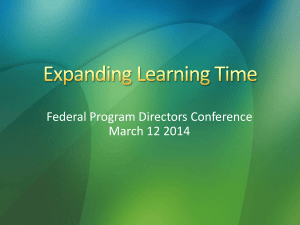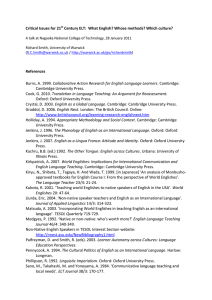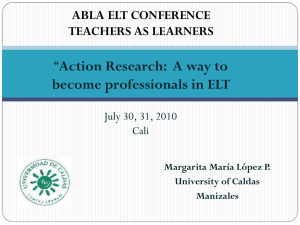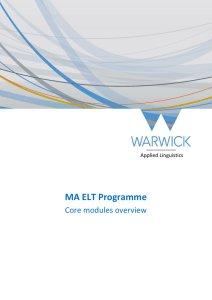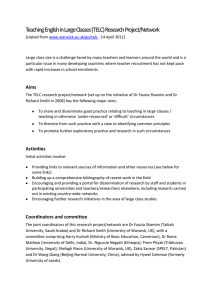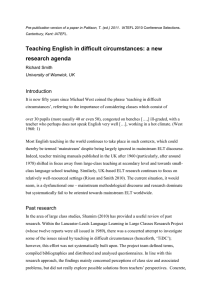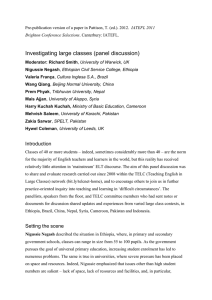Transformations in ELT: Contexts, Agents and Opportunities Introduction
advertisement
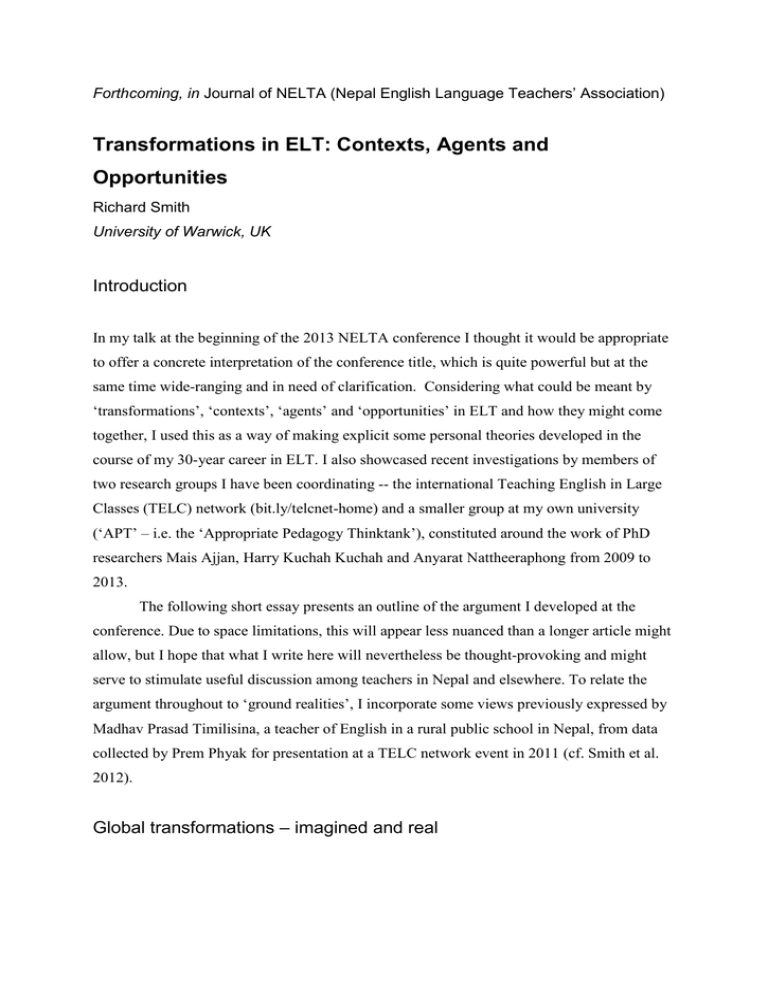
Forthcoming, in Journal of NELTA (Nepal English Language Teachers’ Association) Transformations in ELT: Contexts, Agents and Opportunities Richard Smith University of Warwick, UK Introduction In my talk at the beginning of the 2013 NELTA conference I thought it would be appropriate to offer a concrete interpretation of the conference title, which is quite powerful but at the same time wide-ranging and in need of clarification. Considering what could be meant by ‘transformations’, ‘contexts’, ‘agents’ and ‘opportunities’ in ELT and how they might come together, I used this as a way of making explicit some personal theories developed in the course of my 30-year career in ELT. I also showcased recent investigations by members of two research groups I have been coordinating -- the international Teaching English in Large Classes (TELC) network (bit.ly/telcnet-home) and a smaller group at my own university (‘APT’ – i.e. the ‘Appropriate Pedagogy Thinktank’), constituted around the work of PhD researchers Mais Ajjan, Harry Kuchah Kuchah and Anyarat Nattheeraphong from 2009 to 2013. The following short essay presents an outline of the argument I developed at the conference. Due to space limitations, this will appear less nuanced than a longer article might allow, but I hope that what I write here will nevertheless be thought-provoking and might serve to stimulate useful discussion among teachers in Nepal and elsewhere. To relate the argument throughout to ‘ground realities’, I incorporate some views previously expressed by Madhav Prasad Timilisina, a teacher of English in a rural public school in Nepal, from data collected by Prem Phyak for presentation at a TELC network event in 2011 (cf. Smith et al. 2012). Global transformations – imagined and real Issues of multicultural education, quality education, sustainable education etc. are in the debate and World-class education has been a felt need but we have crowded classes with lack of resources. (Timilisina n.d.) In industrialized countries’ education systems, there are currently major changes occurring which are often assumed to be having an impact on English teaching worldwide. Thus, widespread use of information and communication technology (ICT) is often highlighted as one of the most important developments affecting teachers and students these days, but many developing country classrooms have little more than human resources, chalkboards and textbooks – sometimes even textbooks are lacking. Indeed, rather than technological advances, a more important recent development -- as perceived by teachers in developing country contexts themselves – may have been the way class sizes seem to keep on rising, with little concomitant increase in material support. This trend towards larger and larger classes has brought strains on resources and has probably contributed to increasing problems of teacher demotivation and burnout (Wyatt 2013), even though there is a positive side -- increasing class sizes in developing countries have, after all, resulted at least partly from governments’ pursuit of the United Nations ‘Education for all’ goals (UNESCO 2000: 15--17), with two of these (Goals 2 and 5) necessarily entailing an increase in school populations. In many cases, though, the pace of teacher recruitment has failed to meet new demands for places. The widely recognized trend towards teaching English at a younger and younger age worldwide (Rixon 2013) has been adding further pressures in developing country contexts. There are large-scale needs worldwide for more teachers of English at primary level, and for developing the English proficiency of existing teachers. Overall, it can be seen that there are new opportunities but also many new challenges for ELT professionals in developing countries within a changing world environment. As highlighted in Timilisina’s words above, a rhetoric of positive ‘transformation’ is pervasive but, by and large, poorly matched to ground realities in developing countries, where the constraints on effective teaching can often seem overwhelming and may be increasing, not diminishing. In this context, it is important to note the seductive but potentially empty appeal of some solutions that have been proposed. It may seem logical to assert that if the large-scale ‘global’ challenges presenting themselves these days are to be met, solutions are required which are themselves very large in scope. For example, the following means of ‘delivering’ teacher training to large numbers of teachers are all currently being attempted in various developing countries: • Cascade training – i.e. training a cadre of trainers in new approaches, methods or techniques, who then train other teachers, who may then train others; • ICT / mobile phone mediated teacher training; • ‘Global’ products and distance courses of various kinds. Although big, relatively top-down initiatives via such means may seem to be called for, a major transformation has occurred over the last twenty years within the ‘world’ of ELT discourse itself, and a new body of reflection and research now serves as a counter-weight to prevalent hopes for universal, large scale solutions. Since the publication of Phillipson’s (1992) Linguistic Imperialism, what might be termed a ‘critical turn’ has occurred in ELT discourse, so that universalist solutions involving the top-down, centre to periphery transmission to teachers of particular ‘methods’, techniques, resources, and so on, are no longer seen as appropriate or adequate. Increasingly, neo-colonialism and cultural imperialism have been highlighted as dangers within donor agency efforts to (help) bring about ELT reform in developing country contexts. It could even be said that there has been a massive collective failure of leading institutions (publishers, testing and other agencies, NGOs, universities, ministries of education) to bring real, lasting benefit to teachers and learners of English in developing countries (as opposed to offering ‘solutions’ which suit their own interests, commercial or otherwise). In line with this, there may have actually been few real ‘transformations’, in the problems or practices of the vast majority of teachers in difficult circumstances over the years. As Timilisina (n.d.) puts this, Now, I am a teacher and I have been teaching different subjects for more than a decade. I am facing similar problem as my teachers faced. I have to teach more than sixty students in the same class and I know that some of my friends are teaching more than a hundred. Nowadays the reality of this kind of situation can at least begin to be addressed, due to the critical turn in ELT and the recognition that ideas developed in relatively well-resourced ‘BANA’ (Holliday 1994) contexts are not necessarily appropriate in ‘TESEP’ (ibid.) or ‘periphery’ (Phillipson 1992) classrooms. From the perspective of this still ongoing transformation in perceptions within ELT, all types of large-scale, top-down innovation, whether mediated by the latest technology or otherwise, are flawed to the extent that they continue to ignore context in the contents of training, fail to engage teacher agency, and thereby fail to ‘take hold’. Instead, more localized, bottom-up innovations are called for as an alternative to decades of inappropriate top-down reform. The next section will explore what such innovations could look like, attempting to answer the question, in concrete terms, how can appropriate innovations be developed which are sustainable in the relatively difficult circumstances typical of most English teaching in the world? Teachers transforming themselves A common response among teachers to innovations coming from ‘on high’ is to subsume them within existing personal construct systems and/or to carry on teaching much as before, sometimes adopting new, fashionable labels for what they had already been doing anyway (Erdoğan 2005; Nattheeraphong 2013) . This is evident from the way ‘traditional’ language teaching approaches (often involving explicit teaching of grammar in students’ mother tongue, repetition of vocabulary items, reading aloud and translation exercises) have retained their dominance in (probably) most education systems in the world, despite periodic attempts to change these practices (cf. Smith and Imura 2004). However, this does not mean at all that individual teachers are necessarily creatures of habit or ‘hidebound’ by tradition. Indeed, I have increasingly come to realize that there are inspiring stories waiting to be collected and shared of teachers rising above the difficult conditions they face, ‘taking the bull by its horns’ as leading Pakistani teacher educator Zakia Sarwar puts it (see Smith 2008), and making small but significant changes which improve conditions for themselves and their students. For example, in the case of the Nepali teacher whose words have been accompanying mine in this essay: I am not satisfied with what I have done to solve my problem; [however,] the steps I have taken in the class have at least reduced dropout and repetition [i.e. students having to repeat a year of work] to some degree. (Timilisina n.d.) Let’s come back soon to some of the steps Timilisina took to improve the situation for students in his classrooms. Before that, though, I would like to briefly introduce the overall research approach we have adopted within the APT group at Warwick University, which has been concerning itself with the issue of what contextually appropriate methodology might look like. We have come up with a basic three-stage process which involves ways of (1) identifying, (2) describing / understanding and (3) sharing practices which have been developed by – and have shown their worth to -- teachers in a specific context. In relation to stage (3), for example, the merits of the following kind of idea from a Nepali rural public school teacher (Timilisina ibid.) could serve as a starting-point for discussion among teachers in similar multicultural large class conditions, in Nepal and perhaps beyond: Nearly four different ethnic communities are available in the catchment area of my school. Students from Newari community speak Newari language as their first language and Paharis, Tamangs and Magars have their own language (except Paharis) and culture. Using some aspects of their language and talking about their feasts and festival in the class, I address their linguistic as well as cultural identity. As a result, they all feel welcome in the class even if it is crowded. Now that this idea has been uncovered in the practice of one teacher (and I have not seen it mentioned before in the literature on large classes, apart from by Phyak 2011), a question to be asked to other teachers in a Nepali teacher training context could be: ‘If you are a teacher in this kind of situation, how do (or how could) you engage your own students’ multiple linguistic and cultural identities?’. The ensuing discussion – if recorded and reported further – could serve to develop the notion of multicultural/multilinguistic engagement as one element of a broader appropriate methodology for Nepal and perhaps beyond, at the same time as benefitting those present themselves. Here is another case of the same teacher utilising the human resources in large-class and otherwise unfavourable circumstances: A few talented students generally dominate the large size classes. They can help the teacher to teach effectively. My way of mobilizing them helps me. I place them in different benches and assign them to help other weak students. Another way that I use is to administer Proficiency test before I start the course. According to the score they obtain, they are placed in such a way that the weak students will get helping hands. (Timilisina n.d.) A question to ask here in a teacher training context might be: ‘Have you found or heard of ways to mobilize the stronger students to help you overcome problems in large classes?’. Sharing such solutions together can, again, contribute to the development of appropriate methodology and they are unlikely to emerge from outside sources, concerned as these often are with relatively small-class settings. The positive power of identifying ‘good practices’ as perceived by participants in the context concerned, describing /interpreting them, and sharing them has been further demonstrated in, for example, Kuchah and Smith (2011), and by Ajjan (2011) and Kuchah (2013) in their recently completed PhD studies. More recently still, the same approach has been extended to a larger-scale but still relatively bottom-up project in Cameroon, where stories of positive practice are being collected and shared across a whole Teacher Association (Smith and Kuchah forthcoming). Indeed, I hope this latter initiative can be the start of a major concerted effort by teacher associations and allied researchers to help teachers identify successes they have achieved despite difficult circumstances – and to promote sharing of these successes in support of the development of contextually appropriate methodologies. Investigations are needed which show teachers in a positive light, which highlight and reflect back to them their existing agency, and which encourage them to go further. The bottom-up exploration of ‘good practices’ as defined by teachers (and learners) themselves has hardly been attempted in the past but offers a promising new direction for teacher development and education. As Timilisina (n.d.) says, putting it more authentically than I can hope to: Large size class is not only a problem or burden of teachers but also an opportunity to explore new techniques and tools. (Timilisina n.d.) Conclusion Here is a summary of the way I interpret the conference theme, highlighting its concrete relevance to teachers in the form of a challenging question: How can you, in cooperation with others, bring about appropriate transformations in your ELT practice, in your own context, as an agent – at least partially – of your own destiny, and what opportunities do you see for supporting your students’ as well as your own development? Madhav Prasad Timilisina, whose work we have glimpsed throughout this account, represents one case of a teacher in unfavourable circumstances who has transformed his practice, despite the difficulties, and whose experience can serve as an inspiration to others in similar settings. Why look outside for solutions? Sources of transformation lie in the experience of teachers like him, and like you! Email: R.C.Smith@warwick.ac.uk References Ajjan, M. (2011). ‘Large class teaching in Syria: Students’ perspectives’. Online talk: http://www2.warwick.ac.uk/fac/soc/al/research/projects/telc/training/maisajjanresearchpresen tation.mp4 Erdoğan, S. 2005. ‘Experienced EFL teachers’ personal theories of good teaching: A PCTbased investigation’. PhD thesis, University of Warwick. Holliday, A. 1994. Appropriate Methodology and Social Context. Cambridge: Cambridge University Press. Kuchah, K. 2013. ‘Context appropriate ELT pedagogy: an investigation in Cameroonian primary schools’. PhD thesis, University of Warwick. Kuchah, K. and Smith, R. 2011. ‘Pedagogy of autonomy for difficult circumstances: From practice to principles’. Innovation in Language Learning and Teaching 5/2: 119-139. Nattheeraphong, A. 2013. ‘Teachers’ beliefs about appropriate methodology in Thai secondary level English education’. PhD thesis, University of Warwick. Phillipson, R. 1992. Linguistic Imperialism. Oxford: Oxford University Press. Phyak, P.B. 2011. 'Teaching English in large multicultural classes: a narrative enquiry'. In Pattison, T. (ed.) IATEFL 2010 Harrogate Conference Selections. Canterbury: IATEFL. Rixon, S. 2013. British Council Survey of Policy and Practice in Primary English Language Teaching Worldwide. London: The British Council. Available online: http://www.teachingenglish.org.uk/sites/teacheng/files/D120%20Survey%20of%20Teachers %20to%20YLs_FINAL_Med_res_online.pdf/. Smith, R. 2008. 'Taking the bull by its horns: Zakia Sarwar's pro-autonomy approach to large classes in Pakistan (Part I)'. Independence 44: 7-13. Also available online: http://lasig.iatefl.org/uploads/1/1/8/3/11836487/seitenaus44.pdf Smith, R.C. with Imura, M. 2004. ‘Lessons from the past: traditions and reforms’, In Makarova, V. and T. Rodgers (eds.) English Language Teaching: The Case of Japan. Munich: Lincom Europa. Also available online: www.warwick.ac.uk/go/elt_archive/publications/j._lessons.pdf Smith, R. and Kuchah, K. In press. ‘Teacher association research: An innovative form of teacher-research’. Voices [IATEFL newsletter] (January-February 2014). Smith, R., with Negash, N., França, V., Wang, Q., Phyak, P., Ajjan, M., Kuchah, H.K., Saleem, M., Sarwar, Z., and Coleman, H. 2012. ‘Panel discussion on investigating large classes'. In Pattison, T. (ed.) IATEFL 2011 Brighton Conference Selections. Canterbury: IATEFL. Timilisina, M.P. n.d. ‘My personal experience of being in crowded class and having crowded class’. Data collected by Prem Phyak for the TELC network. Online: http://www2.warwick.ac.uk/fac/soc/al/research/projects/telc/3._prem_phyak_data_stories_0.p df Teaching English in Large Classes (TELC) Network website: bit.ly/telcnet-home; UNESCO 2000. The Dakar Framework for Action (Education for All: Meeting Our Collective Commitments). Paris: UNESCO. Online: http://unesdoc.unesco.org/images/0012/001211/121147e.pdf Wedell, M. (2009). Planning for Educational Change: Putting People and Their Contexts First. London: Continuum. Wyatt, M. 2013’ ‘Motivating teachers in the developing world: Insights from research with English teachers in Oman’. International Review of Education 59/2: 217-242.
